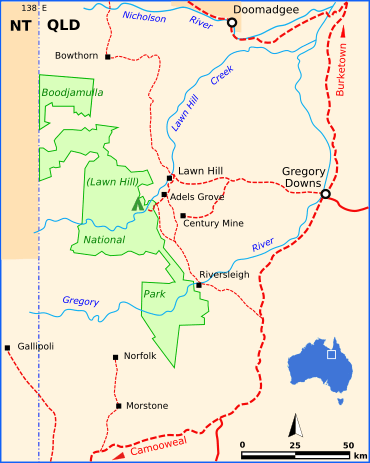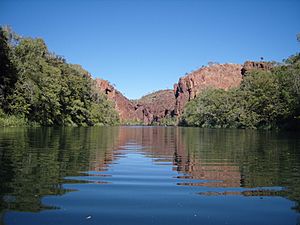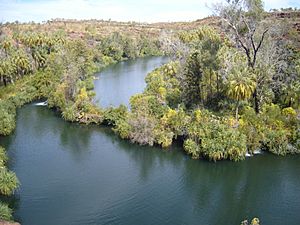Boodjamulla National Park facts for kids
Quick facts for kids Boodjamulla National ParkQueensland |
|
|---|---|
|
IUCN Category II (National Park)
|
|

Boodjamulla National Park
|
|
| Nearest town or city | Burketown |
| Established | 1985 |
| Area | 2,820 km2 (1,088.8 sq mi) |
| Managing authorities | Queensland Parks and Wildlife Service |
| Website | Boodjamulla National Park |
| See also | Protected areas of Queensland |
Boodjamulla National Park, once called Lawn Hill National Park, is a special protected area in Queensland, Australia. It's located in the Shire of Burke. Inside the park, you'll find the Riversleigh World Heritage Area, which is a very important World Heritage Site.
This park is on the traditional lands of the Waanyi people. They have lived here for a very long time. In the 1870s, European settlers arrived and started raising cattle. Many smaller farms were combined to form Lawn Hill Station. This became one of Queensland's biggest cattle stations. Later, in 1984, the owner gave some of this land to the government. More land was added in 1992. This was done so the land could be used for everyone's benefit.
The park has amazing sandstone ranges. Rivers and creeks flow through them. The most famous spot is Lawn Hill Gorge. The park is also home to many different animals and plants. It is known as an Important Bird Area because so many birds live there.
Contents
Where is Boodjamulla National Park?
This park is in the Gulf Country area of northwestern Queensland. It is about 340 km (211 mi) northwest of Mount Isa. From Brisbane, it is about 1,837 km (1,141 mi) to the northwest.
The park's main features are its sandstone ranges. These have deep gorges carved into them. There is also a limestone plateau with important fossil sites. Visitors love the clear green waters and lush plants. Canoeing is a popular activity here. Around the park, there are areas set aside for finding and digging up minerals.
The History of Boodjamulla
The Waanyi people have lived in the gorge area for at least 17,000 years. They call this place Boodjamulla, which means Rainbow Serpent country. Lawn Hill Gorge is a sacred place for them. You can find old camp sites, grinding stones, and rock art here. These show how important this place has been. Today, the Waanyi people help manage the park.
The park also has a history of farming. Until 1984, it was part of Lawn Hill Station. This was once one of Queensland's largest cattle properties. The cattle station was created from several land leases given in the 1870s. In 1976, Sebastião Ferreira Maia owned the station. He gave 122 km² (47 sq mi) of the land back to the state in 1984. He asked that it be managed for everyone to enjoy. In 1992, another 1,350 km² (521 sq mi) was added to the park.
The Riversleigh and Musselbrook areas became part of the park in 1992. The Riversleigh Fossil Fields are a World Heritage Site. They hold many fossils. Animal bones from 25 million years ago are kept safe in the lime-rich soil.
What You Can See in the Park
The park has several creeks and waterholes that always have water. It also has many gorges and sandstone ranges. Over millions of years, Boodjamulla's old sandstones and limestones have worn away. This has left behind rugged cliffs, gorges, and rock formations. There are four main types of natural areas in the park:
- Areas along rivers
- Flat areas made of river soil
- Rocky hills
- Clay plains
Lawn Hill Gorge is the main attraction. It cuts through the sandstone plateau of the Constance Range. This is on the eastern edge of the Barkly Tableland. Lawn Hill Creek carved out the gorge. This creek flows all year round. It gets its water from freshwater springs in the limestone plateau to the west. The gorge is like a rich oasis. It has cabbage palms and other tropical plants.
The Gregory River and O'Shanassy Rivers also flow all year in the park. There are 20 km (12 mi) of walking tracks for visitors to explore.
Plants and Animals
Plants of Boodjamulla
On the sandstone hills, you will find spinifex grass, acacias, eucalypt trees, and grevilleas. On the river plains, there are western bloodwood trees and mitchell grass. Along the creek and river banks, you can see paperbark trees, river red gums, figs, ferns, pandanus, and cabbage palms. Many water plants grow in the creeks. These include waterlilies, ferns, mosses, sedges, and bulrushes.
Animals of Boodjamulla
Freshwater crocodiles live in the gorge. They usually stay away from people. They might become aggressive if they are disturbed when mating or protecting their babies.
The park is home to the rock ringtail possum. This animal is active at night. Other animals in the park include:
In the creeks, you can find archerfish. There are also endangered red-bellied short-necked turtles and northern snapping turtles. Many other fish species live here too.
You are not allowed to fish in the national park. The only exception is the Gregory River in the Riversleigh section. Wild pigs also live around Lawn Hill. They can cause a lot of damage near the creeks.
Birds of Boodjamulla
BirdLife International has named the park an Important Bird Area. More than 140 types of birds live here. Some of these include:
- Buff-sided robin
- Great bowerbird
- Red-collared lorikeet
- Crimson finch
- Zebra finch
- Kestrel
- Spinifex pigeon
- Barking owl
- Brolga
- Budgerigars
- Wedge-tailed eagle
The park has many Carpentarian grasswrens. It also has a few painted honeyeaters. The rare purple-crowned fairy-wren is the park's special bird emblem.
How to Visit the Park
The park is 100 km (62 mi) west of Gregory. If you are coming from Mount Isa, you will travel north along the Barkly Highway. The easiest way to reach the park is through the Burke & Wills Roadhouse. The road is unsealed, meaning it's not paved. It might be closed after heavy rain. The wet season is from October to March. Because the park is so far away, it's a good idea to bring extra fuel, food, and water.
Camping in the Park
You can camp in two areas:
- Lawn Hill Gorge
- Miyumba bush camp near the Gregory River
The Lawn Hill Gorge campsite has toilets and showers. Only one vehicle is allowed per campsite here. This site is not good for caravans or vehicles longer than 4 m (13 ft). You need a permit to camp, and it's important to book ahead. This is especially true from Easter to October.
See also
 In Spanish: Parque nacional Boodjamulla para niños
In Spanish: Parque nacional Boodjamulla para niños



